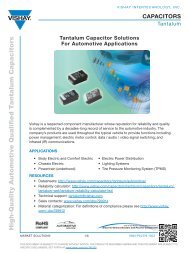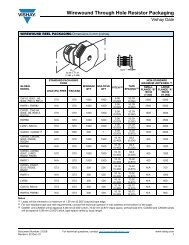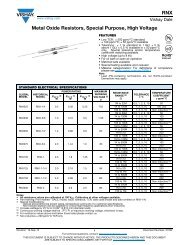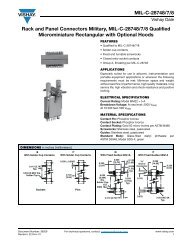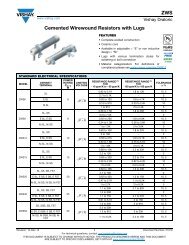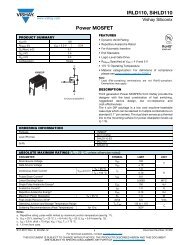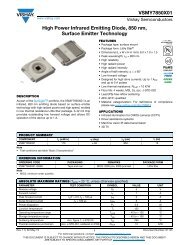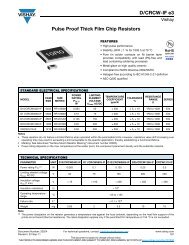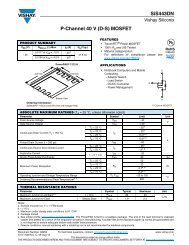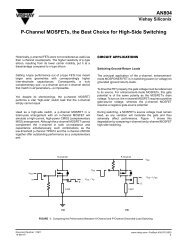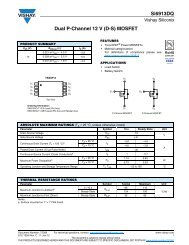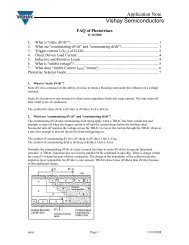TFDU6103 Datasheet - Vishay
TFDU6103 Datasheet - Vishay
TFDU6103 Datasheet - Vishay
Create successful ePaper yourself
Turn your PDF publications into a flip-book with our unique Google optimized e-Paper software.
www.vishay.comNot for New Designs<strong>TFDU6103</strong><strong>Vishay</strong> SemiconductorsFast Infrared Transceiver Module (FIR, 4 Mbit/s)for 2.4 V to 5.5 V Operation20110DESCRIPTIONThe <strong>TFDU6103</strong> is a low-power infrared transceiver modulecompliant to the latest IrDA ® physical layer standard for fastinfrared data communication, supporting IrDA speeds up to4 Mbit/s (FIR), and carrier based remote control modes upto 2 MHz. Integrated within the transceiver module are a PINphotodiode, an infrared emitter (IRED), and a low-powerCMOS control IC to provide a total front-end solution in asingle package.<strong>Vishay</strong> FIR transceivers are available in different packageoptions, including this BabyFace package (<strong>TFDU6103</strong>). Thiswide selection provides flexibility for a variety of applicationsand space constraints. The transceivers are capable ofdirectly interfacing with a wide variety of I/O devices whichperform the modulation/demodulation function, includingNational Semiconductor’s PC87338, PC87108 andPC87109, SMC’s FDC37C669, FDC37N769 andCAM35C44, and Hitachi’s SH3. <strong>TFDU6103</strong> has a tri-stateoutput and is floating in shut-down mode with a weakpull-up.APPLICATIONS• Notebook computers, desktop PCs, palmtop computers(Win CE, Palm PC), PDAs• Digital still and video cameras• Printers, fax machines, photocopiers, screen projectors• Telecommunication products (cellular phones, pagers)• Internet TV boxes, video conferencing systems• External infrared adapters (dongles)• Medical an industrial data collectionFEATURES• Supply voltage 2.4 V to 5.5 V, operating idlecurrent (receive mode) < 3.3 mA, shutdowncurrent < 1 μA over full temperature range• Surface mount package, top and side view,9.7 mm x 4.7 mm x 4 mm• Operating temperature - 25 °C to 85 °C• Transmitter wavelength typ. 886 nm, supportingIrDA and remote control• IrDA compliant, link distance > 1 m, ± 15°, window lossesare allowed to still be inside the IrDA spec.• Remote control range > 8 m, typ. 22 m•ESD > 1 kV• Latchup > 100 mA• EMI immunity > 550 V/m for GSM frequency and othermobile telephone bands/(700 MHz to 2000 MHz, noexternal shield)• Split power supply, LED can be driven by a separatepower supply not loading the regulated supply. U.S. pat.no. 6,157,476• Tri-state-receiver output, floating in shut down with aweak pull-up• Eye safety class 1 (IEC 60825-1, ed. 2001), limited LEDon-time, LED current is controlled, no single fault to beconsidered• Qualified for lead (Pb)-free and Sn/Pb processing (MSL4)• Compliant to RoHS directive 2002/95/EC and inaccordance to WEEE 2002/96/ECPRODUCT SUMMARYPART NUMBERDATA RATE(kbit/s)DIMENSIONSH x L x W(mm x mm x mm)LINK DISTANCE(m)OPERATINGVOLTAGE(V)IDLE SUPPLYCURRENT(mA)<strong>TFDU6103</strong> 4000 4 x 9.7 x 4.7 0 to 1 2.4 to 5.5 2Rev. 1.5, 06-Sep-13 1 Document Number: 81211For technical questions, contact: irdasupportAM@vishay.comTHIS DOCUMENT IS SUBJECT TO CHANGE WITHOUT NOTICE. THE PRODUCTS DESCRIBED HEREIN AND THIS DOCUMENTARE SUBJECT TO SPECIFIC DISCLAIMERS, SET FORTH AT www.vishay.com/doc?91000
www.vishay.comNot for New Designs<strong>TFDU6103</strong><strong>Vishay</strong> SemiconductorsPARTS TABLEPART DESCRIPTION QTY/REEL<strong>TFDU6103</strong>-TR3 Oriented in carrier tape for side view surface mounting 1000 pcs<strong>TFDU6103</strong>-TT3 Oriented in carrier tape for top view surface mounting 1000 pcsFUNCTIONAL BLOCK DIAGRAMV CC1Am pl if ie rCo mp ar atorTr i- Stat eDr iv erRXDV CC2SDTXDLo gi candContro lContro lle dDr iv erIR ED C18468GNDPINOUT<strong>TFDU6103</strong>weight 0.2 g17087”U” Option Baby Face (universal)IREDDetector1 2 3 4 5 6 7 8Definitions:In the <strong>Vishay</strong> transceiver datasheets the followingnomenclature is used for defining the IrDA operating modes:SIR: 2.4 kbit/s to 115.2 kbit/s, equivalent to the basic serialinfrared standard with the physical layer version IrPhy 1.0MIR: 576 kbit/s to 1152 kbit/sFIR: 4 Mbit/sVFIR: 16 Mbit/sMIR and FIR were implemented with IrPhy 1.1, followed byIrPhy 1.2, adding the SIR low power standard. IrPhy 1.3extended the low power option to MIR and FIR and VFIR wasadded with IrPhy 1.4. A new version of the standard in anycase obsoletes the former version.NoteWe apologize to use sometimes in our documentation theabbreviation LED and the word light emitting diode instead ofinfrared emitting diode (IRED) for IR-emitters. That is by definitionwrong; we are here following just a bad trend.Typical values are for design aid only, not guaranteed nor subject toproduction testing and may vary with time.PIN DESCRIPTIONPINNUMBER12SYMBOL DESCRIPTION I/O ACTIVEV CC2IRED anodeIREDcathode3 TXD4 RXDConnect IRED anode directly to V CC2 . For voltages higher than 3.6 V an external resistormight be necessary for reducing the internal power dissipation.An unregulated separate power supply can be used at this pinIRED cathode, internally connected to driver transistorThis input is used to transmit serial data when SD is low. An on-chip protection circuitdisables the LED driver if the TXD pin is asserted for longer than 100 μs. When used inconjunction with the SD pin, this pin is also used to set receiver speed modeReceived data output, push-pull CMOS driver output capable of driving a standard CMOSor TTL load. No external pull-up or pull-down resistor is required.Floating with a weak pull-up of 500 k (typ.) in shutdown modeIOHighLowRev. 1.5, 06-Sep-13 2 Document Number: 81211For technical questions, contact: irdasupportAM@vishay.comTHIS DOCUMENT IS SUBJECT TO CHANGE WITHOUT NOTICE. THE PRODUCTS DESCRIBED HEREIN AND THIS DOCUMENTARE SUBJECT TO SPECIFIC DISCLAIMERS, SET FORTH AT www.vishay.com/doc?91000
www.vishay.comNot for New Designs<strong>TFDU6103</strong><strong>Vishay</strong> SemiconductorsPIN DESCRIPTIONPINNUMBER5 SDSYMBOL DESCRIPTION I/O ACTIVEShutdown, also used for dynamic mode switching. Setting this pin active places themodule into shutdown mode. On the falling edge of this signal, the state of the TXD pin issampled and used to set receiver low bandwidth (TXD = low, SIR) or high bandwidth(TXD = high, MIR and FIR) mode6 V CC1 Supply voltage7 NC8 GND GroundABSOLUTE MAXIMUM RATINGSPARAMETER TEST CONDITIONS SYMBOL MIN. TYP. MAX. UNITSupply voltage range,transceiver0 V < V CC2 < 6 V V CC1 - 0.5 + 6 VSupply voltage range,transmitter0 V < V CC1 < 6 V V CC2 - 0.5 + 6.5 VInput currentsFor all pins,except IRED anode pin10 mAOutput sinking current 25 mAPower dissipation See derating curve, figure 6 P D 500 mWJunction temperature T J 125 °CAmbient temperature range(operating)T amb - 25 + 85 °CStorage temperature range T stg - 25 + 85 °CSoldering temperatureSee recommended solder profile(see figure 4)260 °CAverage output current I IRED (DC) 125 mARepetitive pulse output current < 90 μs, t on < 20 % I IRED (RP) 600 mAIRED anode voltage V IREDA - 0.5 + 6.5 VVoltage at all inputs and outputs V IN > V CC1 is allowed V IN 5.5 VNoteReference point ground pin 8, unless otherwise noted.Typical values are for design aid only, not guaranteed nor subject to production testing and may vary with time.EYE SAFETY INFORMATIONSTANDARDIEC/EN 60825-1 (2007-03), DIN EN 60825-1 (2008-05) “SAFETY OF LASER PRODUCTS -Part 1: equipment classification and requirements”, simplified methodIEC 62471 (2006), CIE S009 (2002) “Photobiological Safety of Lamps and Lamp Systems”DIRECTIVE 2006/25/EC OF THE EUROPEAN PARLIAMENT AND OF THE COUNCIL of 5 th April 2006on the minimum health and safety requirements regarding the exposure of workers to risks arising fromphysical agents (artificial optical radiation) (19 th individual directive within the meaning of article 16(1) ofdirective 89/391/EEC)Note<strong>Vishay</strong> transceivers operating inside the absolute maximum ratings are classified as eye safe according the above table.ELECTRICAL CHARACTERISTICS (1)CLASSIFICATIONIClass 1ExemptExemptPARAMETER TEST CONDITIONS SYMBOL MIN. TYP. MAX. UNITTRANSCEIVERSupply voltage V CC 2.4 5.5 VDynamic supply currentReceive mode only, idleIn transmit mode, add additional 85 mA (typ.) for IRED current.Add RXD output current depending on RXD load.SIR mode I CC 1.8 3 mAMIR/FIR mode I CC 2 3.3 mAHighRev. 1.5, 06-Sep-13 3 Document Number: 81211For technical questions, contact: irdasupportAM@vishay.comTHIS DOCUMENT IS SUBJECT TO CHANGE WITHOUT NOTICE. THE PRODUCTS DESCRIBED HEREIN AND THIS DOCUMENTARE SUBJECT TO SPECIFIC DISCLAIMERS, SET FORTH AT www.vishay.com/doc?91000
www.vishay.comNot for New Designs<strong>TFDU6103</strong><strong>Vishay</strong> SemiconductorsELECTRICAL CHARACTERISTICS (1)PARAMETER TEST CONDITIONS SYMBOL MIN. TYP. MAX. UNITShutdown supply currentSD = highT = 25 °C, not ambient lightsensitive, detector is disabled inshutdown modeI SD 0.01 μASD = high, full specifiedtemperature range, not ambient I SD 1 μAlight sensitiveOperating temperature range T A - 25 + 85 °CInput voltage low(TXD, SD)V IL - 0.5 0.5 VTRANSCEIVERInput voltage high(TXD, SD)CMOS level (2) V IH V CC - 0.3 6 VInput leakage current(TXD, SD)V IN = 0.9 x V CC1 I ICH - 1 + 1 μAInput capacitance, TXD, SD C I 5 pFOutput voltage low I OL = 500 μA, C load = 15 pF V OL 0.4 VOutput voltage high I OH = 250 μA, C load = 15 pF V OH 0.9 x V CC1 VOutput RXD current limitationhigh statelow stateShort to groundShort to V CC12020SD shutdown pulse duration Activating shutdown 30 μsRXD to V CC1 impedance R RXD 400 500 600 kSD mode programming pulseAll modes tdurationSDPW 200 nsNote(1) T amb = 25 °C, V CC1 = V CC2 = 2.4 V to 5.5 V unless otherwise noted.Typical values are for design aid only, not guaranteed nor subject to production testing.(2) The typical threshold level is 0.5 x V CC1 (V CC1 = 3 V). It is recommended to use the specified min./max. values to avoid increased operatingcurrent.OPTOELECTRONIC CHARACTERISTICS (1)PARAMETER TEST CONDITIONS SYMBOL MIN. TYP. MAX. UNITRECEIVERMinimum irradiance E e inangular range (3) SIR modeMinimum irradiance E e inangular range, MIR modeMinimum irradiance E einangular range, FIR mode9.6 kbit/s to 115.2 kbit/s = 850 nm to 900 nm1.152 Mbit/s = 850 nm to 900 nm4 Mbit/s = 850 nm to 900 nmE e25(2.5)E e65(6.5)E e80(8)Maximum irradiance E e inangular range (4) = 850 nm to 900 nm E e5(500)Maximum no detectionirradiance(2) E e4(0.4)35(3.5)90(9)mAmAmW/m 2(μW/cm 2 )mW/m 2(μW/cm 2 )mW/m 2(μW/cm 2 )kW/m 2(mW/cm 2 )mW/m 2(μW/cm 2 )Rise time of output signal 10 % to 90 %, 15 pF t r (RXD) 10 40 nsFall time of output signal 90 % to 10 %, 15 pF t f (RXD) 10 40 nsRXD pulse width of outputsignal, 50 %, SIR modeRXD pulse width of outputsignal, 50 %, MIR modeInput pulse length, 1.4 μs < P Wopt < 25 μs t PW 2.1 μsInput pulse length, 1.4 μs < P Wopt < 25 μs,- 25 °C < T < 85 °C (5) t PW 1.5 1.8 2.6 μsInput pulse length, P Wopt = 217 ns,1.152 Mbit/st PW 110 250 270 nsRev. 1.5, 06-Sep-13 4 Document Number: 81211For technical questions, contact: irdasupportAM@vishay.comTHIS DOCUMENT IS SUBJECT TO CHANGE WITHOUT NOTICE. THE PRODUCTS DESCRIBED HEREIN AND THIS DOCUMENTARE SUBJECT TO SPECIFIC DISCLAIMERS, SET FORTH AT www.vishay.com/doc?91000
www.vishay.comNot for New Designs<strong>TFDU6103</strong><strong>Vishay</strong> SemiconductorsOPTOELECTRONIC CHARACTERISTICS (1)PARAMETER TEST CONDITIONS SYMBOL MIN. TYP. MAX. UNITRXD pulse width of outputsignal, 50 %, FIR modeStochastic jitter, leading edgeInput pulse length, P Wopt = 125 ns,4 Mbit/sInput pulse length, P Wopt = 250 ns,4 Mbit/st PW 100 140 nst PW 225 275 nsInput irradiance = 100 mW/m 2 , 4 Mbit/s 20 nsInput irradiance = 100 mW/m 2 , 1.152 Mbit/s 40 nsInput irradiance = 100 mW/m 2 , 576 kbit/s 80 nsInput irradiance = 100 mW/m 2 , 115.2 kbit/s 350 nsAfter completion of shutdown programmingReceiver start up time250 μssequence power on delayLatency t L 40 100 μsTRANSMITTERIRED operating current,switched current limiterNote: no external current limiting resistor isneeded forV CC1 = V CC2 = 3.3 VI D 330 440 600 mAInput pulse width t < 20 μs t pw t μsOutput pulse width limitation Input pulse width 20 μs < t < 150 μs t pw 18 150 μsInput pulse width t 150 μs t pw_lim 150 μsOutput leakage IRED current I IRED - 1 1 μAOutput radiant intensity,see figure 1, recommendedapplication circuitOutput radiant intensity,see figure 1, recommendedapplication circuitV CC = V IRED = 3.3 V, = 0°TXD = high, SD = low, R1 = 1 V CC = V IRED = 3.3 V, = 0°, 15°TXD = high, SD = low, R1 = 1 I e 110 170 468 (6) mW/srI e 100 130 468 (6) mW/srOutput radiant intensityV CC1 = 3.3 V, = 0°, 15°TXD = low or SD = high (receiver is inactive as long I e 0.04 mW/sras SD = high)Output radiant intensity, angleof half intensitya ± 24 degPeak - emission wavelength (7) p 875 886 900 nmSpectral bandwidth Dl 45 nmOptical rise time,Optical fall timet ropt ,t fopt10 40 nsInput pulse width 217 ns, 1.152 Mbit/s t opt 207 217 227 nsOptical output pulse durationInput pulse width 125 ns, 4 Mbit/s t opt 117 125 133 nsInput pulse width 250 ns, 4 Mbit/s t opt 242 250 258 nsOptical overshoot 25 %Notes(3) T amb = 25 °C, V CC = 2.4 V to 5.5 V unless otherwise noted. All timing data measured with 4 Mbit/s are measured using the IrDA FIRtransmission header. The data given here are valid 5 μs after starting the preamble.Typical values are for design aid only, not guaranteed nor subject to production testing.(4) This parameter reflects the backlight test of the IrDA physical layer specification to guarantee immunity against light from fluorescent lamps.(5) IrDA sensitivity definition: minimum irradiance E e in angular range, power per unit area. The receiver must meet the BER specification whilethe source is operating at the minimum intensity in angular range into the minimum half-angular range at the maximum link length.(6) Maximum irradiance E e in angular range, power per unit area. The optical delivered to the detector by a source operating at the maximumintensity in angular range at minimum link length must not cause receiver overdrive distortion and possible related link errors. If placed atthe active output interface reference plane of the transmitter, the receiver must meet its bit error ratio (BER) specification. For moredefinitions see the document “Symbols and Terminology” on the <strong>Vishay</strong> website(7) Retriggering once during applied optical pulse may occur.(8) Maximum value is given by eye safety class 1, IEC 60825-1, simplified method.(9) Due to this wavelength restriction compared to the IrDA spec of 850 nm to 900 nm the transmitter is able to operate as source for thestandard remote control applications with codes as e.g. Philips RC5/RC6 ® or RECS 80. When operated under IrDA full range conditions(125 mW/sr) the RC range to be covered is in the range from 8 m to 12 m, provided that state of the art remote control receivers are used.Rev. 1.5, 06-Sep-13 5 Document Number: 81211For technical questions, contact: irdasupportAM@vishay.comTHIS DOCUMENT IS SUBJECT TO CHANGE WITHOUT NOTICE. THE PRODUCTS DESCRIBED HEREIN AND THIS DOCUMENTARE SUBJECT TO SPECIFIC DISCLAIMERS, SET FORTH AT www.vishay.com/doc?91000
www.vishay.comNot for New Designs<strong>TFDU6103</strong><strong>Vishay</strong> SemiconductorsRECOMMENDED CIRCUIT DIAGRAM<strong>Vishay</strong> Semiconductors transceivers integrate a sensitivereceiver and a built-in power driver. The combination of bothneeds a careful circuit board layout. The use of thin, long,resistive and inductive wiring should be avoided. The inputs(TXD, SD) and the output RXD should be directly (DC)coupled to the I/O circuit.Vcc2Vcc1GNDSDTXDRXD19789R2C1R1C3IRED AnodeFig. 1 - Recommended Application CircuitThe capacitor C1 is buffering the supply voltage andreduces the influence of the inductance of the power supplyline. This one should be a Tantalum or other fast capacitorto guarantee the fast rise time of the IRED current. Theresistor R1 is only necessary for higher operating voltagesC2VccGroundSDTXDRXDIRED Cathodeand elevated temperatures, see derating curve in figure 6, toavoid too high internal power dissipation.The capacitors C2 and C3 combined with the resistor R2 (asthe low pass filter) is smoothing the supply voltage V CC1 . R2,C1, C2, and C3 are optional and dependent on the quality ofthe supply voltages V CC1 and V CC2 and injected noise. Anunstable power supply with dropping voltage duringtransmission may reduce sensitivity (and transmissionrange) of the transceiver. The placement of these parts iscritical. It is strongly recommended to position C2 and C3 asclose as possible to the transceiver power supply pins. Antantalum capacitor should be used for C1 and C3 while aceramic capacitor is used for C2.In addition, when connecting the described circuit to thepower supply, low impedance wiring should be used.When extended wiring is used the inductance of the powersupply can cause dynamically a voltage drop at V CC2 . Oftensome power supplies are not able to follow the fast currentrise time. In that case another 4.7 μF (type, see table underC1) at V CC2 will be helpful.Keep in mind that basic RF-design rules for circuit designshould be taken into account. Especially longer signal linesshould not be used without termination. See e.g. “The Art ofElectronics” Paul Horowitz, Wienfield Hill, 1989, CambridgeUniversity Press, ISBN: 0521370957.TABLE 1 - RECOMMENDED APPLICATION CIRCUIT COMPONENTSCOMPONENT RECOMMENDED VALUE VISHAY PART NUMBERC1, C3 4.7 μF, 16 V 293D 475X9 016BC2 0.1 μF, ceramic VJ 1206 Y 104 J XXMTR13.3 V supply voltage: no resistors necessary, the internalcontroller is able to control the currente.g. 2 x CRCW-1206-1R0-F-RT1R2 10 , 0.125 W CRCW-1206-10R0-F-RT1I/O AND SOFTWAREIn the description, already different I/Os are mentioned.Different combinations are tested and the function verifiedwith the special drivers available from the I/O suppliers. Inspecial cases refer to the I/O manual, the <strong>Vishay</strong> applicationnotes, or contact directly <strong>Vishay</strong> Sales, Marketing orApplication.MODE SWITCHINGThe <strong>TFDU6103</strong> is in the SIR mode after power on as adefault mode, therefore the FIR data transfer rate has to beset by a programming sequence using the TXD and SDinputs as described below. The low frequency mode coversspeeds up to 115.2 kbit/s. Signals with higher data ratesshould be detected in the high frequency mode. Lowerfrequency data can also be received in the high frequencymode but with reduced sensitivity.To switch the transceivers from low frequency mode to thehigh frequency mode and vice versa, the programmingsequences described below are required.(0.576 Mbit/s to 4 Mbit/s)1. Set SD input to logic “high”.(2)Set TXD input to logic “high”. Wait t s 200 ns.(3)Set SD to logic “low” (this negative edge latches state ofTXD, which determines speed setting).(4)After waiting t h 200 ns TXD can be set to logic “low”.The hold time of TXD is limited by the maximum allowedpulse length.After that TXD is enabled as normal TXD input and thetransceiver is set for the high bandwidth (576 kbit/s to4 Mbit/s) mode.SETTING TO THE HIGH BANDWIDTH MODERev. 1.5, 06-Sep-13 6 Document Number: 81211For technical questions, contact: irdasupportAM@vishay.comTHIS DOCUMENT IS SUBJECT TO CHANGE WITHOUT NOTICE. THE PRODUCTS DESCRIBED HEREIN AND THIS DOCUMENTARE SUBJECT TO SPECIFIC DISCLAIMERS, SET FORTH AT www.vishay.com/doc?91000
www.vishay.comNot for New Designs<strong>TFDU6103</strong><strong>Vishay</strong> SemiconductorsSETTING TO THE LOWER BANDWIDTH MODE(2.4 kbit/s to 115.2 kbit/s)1. Set SD input to logic “high”.(2)Set TXD input to logic “low”. Wait t s 200 ns.(3)Set SD to logic “low” (this negative edge latches state ofTXD, which determines speed setting).(4)TXD must be held for t h 200 ns.After that TXD is enabled as normal TXD input and thetransceiver is set for the lower bandwidth (9.6 kbit/s to115.2 kbit/s) mode.NoteWhen applying this sequence to the device already in the lowerbandwidth mode, the SD pulse is interpreted as shutdown. In thiscase the RXD output of the transceiver may react with a single pulse(going active low) for a duration less than 2 μs. The operatingsoftware should take care for this condition.In case the applied SD pulse is longer than 4 μs, no RXD pulse is tobe expected but the receiver startup time is to be taken into accountbefore the device is in receive condition.SD50 %TXDt s t hHigh: FIR50 %50 %Low: SIRFig. 2 - Mode Switching Timing Diagram14873TABLE 2 - TRUTH TABLEINPUTSOUTPUTSSD TXD OPTICAL INPUT IRRADIANCE mW/m 2 RXD TRANSMITTERHigh x x Weakly pulled (500 k) to V CC1 0LowHigh x Low (active) I eHigh > 150 μs x High 0Low < 4 High 0Low> min. irradiance E e< max. irradiance E eLow (active) 0Low > max. irradiance E e x 0RECOMMENDED SOLDER PROFILESSolder Profile for Sn/Pb SolderingTemperature (°C)260240240 °C max.10 s max. at 230 °C2202002 to 4 °C/s180160160 °C max.140120120 to180 s90 s max.10080 2 to 4 °C/s60402000 50 100 150 200 250 300 35019535Time/sFig. 1 - Recommended Solder Profile for Sn/Pb solderingLead (Pb)-free, Recommended Solder ProfileThe <strong>TFDU6103</strong> is a lead (Pb)-free transceiver and qualifiedfor lead (Pb)-free processing. For lead (Pb)-free solder pastelike Sn (3.0 - 4.0) Ag (0.5 - 0.9) Cu, there are two standard reflowprofiles: Ramp-Soak-Spike (RSS) and Ramp-To-Spike(RTS). The Ramp-Soak-Spike profile was developedprimarily for reflow ovens heated by infrared radiation. Withwidespread use of forced convection reflow ovens theRamp-To-Spike profile is used increasingly. Shown infigure 4 and 5 are <strong>Vishay</strong>'s recommended profiles for usewith the <strong>TFDU6103</strong> transceivers. For more details pleaserefer to the application note “SMD Assembly Instructions”.A ramp-up rate less than 0.9 °C/s is not recommended.Ramp-up rates faster than 1.3 °C/s could damage an opticalpart because the thermal conductivity is less than comparedto a standard IC.Wave SolderingFor TFDUxxxx and TFBSxxxx transceiver devices wavesoldering is not recommended.Manual SolderingManual soldering is the standard method for lab use.However, for a production process it cannot berecommended because the risk of damage is highlydependent on the experience of the operator. Nevertheless,we added a chapter to the above mentioned applicationnote, describing manual soldering and desoldering.Rev. 1.5, 06-Sep-13 7 Document Number: 81211For technical questions, contact: irdasupportAM@vishay.comTHIS DOCUMENT IS SUBJECT TO CHANGE WITHOUT NOTICE. THE PRODUCTS DESCRIBED HEREIN AND THIS DOCUMENTARE SUBJECT TO SPECIFIC DISCLAIMERS, SET FORTH AT www.vishay.com/doc?91000
Not for New Designswww.vishay.comStorageThe storage and drying processes for all <strong>Vishay</strong> transceivers(TFDUxxxx and TFBSxxx) are equivalent to MSL4. The datafor the drying procedure is given on labels on the packingand also in the application note “Taping, Labeling, Storageand Packing”.Temperature/°C275250T ≥ 255 °C for 10 s....30 sT peak = 260 °C225T ≥ 217 °C for 70 s max.20017515030 s max.12510090 s to 120 s 70 s max.752 °C/s to 4 °C/s50 2 °C/s to 3 °C/s2500 50 100 150 200 250 300 35019532Time/sAmbient Temperature (°C)908580757065605518097<strong>TFDU6103</strong><strong>Vishay</strong> Semiconductors502 2.5 3 3.5 4 4.5 5 5.5 6Operating Voltage (V) at Duty Cycle 20 %Fig. 4 - Temperature Derating DiagramFig. 2 - Solder Profile, RSS Recommendation280240T peak = 260 °C max.Temperature/°C200160120801.3 °C/s< 4 °C/sTime above 217 °C t ≤ 70 sTime above 250 °C t ≤ 40 s < 2 °C/sPeak temperature T peak = 260 °C4000 50 100 150 200 250 300TFDU Fig3Time/sFig. 3 - RTS RecommendationCURRENT DERATING DIAGRAMFigure 6 shows the maximum operating temperature whenthe device is operated without external current limitingresistor. A power dissipating resistor of 2 is recommendedfrom the cathode of the IRED to ground for supply voltagesabove 4 V. In that case the device can be operated up to85 °C, too.Rev. 1.5, 06-Sep-13 8 Document Number: 81211For technical questions, contact: irdasupportAM@vishay.comTHIS DOCUMENT IS SUBJECT TO CHANGE WITHOUT NOTICE. THE PRODUCTS DESCRIBED HEREIN AND THIS DOCUMENTARE SUBJECT TO SPECIFIC DISCLAIMERS, SET FORTH AT www.vishay.com/doc?91000
www.vishay.comPACKAGE DIMENSIONS in millimetersNot for New Designs<strong>TFDU6103</strong><strong>Vishay</strong> Semiconductors20111Fig. 5 - Package Drawing and Solder Footprints for Top and Side View Mounting <strong>TFDU6103</strong>,Tolerance ± 0.2 mm if not otherwise mentionedRev. 1.5, 06-Sep-13 9 Document Number: 81211For technical questions, contact: irdasupportAM@vishay.comTHIS DOCUMENT IS SUBJECT TO CHANGE WITHOUT NOTICE. THE PRODUCTS DESCRIBED HEREIN AND THIS DOCUMENTARE SUBJECT TO SPECIFIC DISCLAIMERS, SET FORTH AT www.vishay.com/doc?91000
Not for New Designswww.vishay.com<strong>TFDU6103</strong><strong>Vishay</strong> SemiconductorsREEL DIMENSIONS in millimetersDrawing-No.: 9.800-5090.01-4Issue: 1; 29.11.0514017TAPE WIDTH(mm)A MAX.(mm)N(mm)W 1 MIN.(mm)W 2 MAX.(mm)W 3 MIN.(mm)W 3 MAX.(mm)24 330 60 24.4 30.4 23.9 27.4Rev. 1.5, 06-Sep-13 10 Document Number: 81211For technical questions, contact: irdasupportAM@vishay.comTHIS DOCUMENT IS SUBJECT TO CHANGE WITHOUT NOTICE. THE PRODUCTS DESCRIBED HEREIN AND THIS DOCUMENTARE SUBJECT TO SPECIFIC DISCLAIMERS, SET FORTH AT www.vishay.com/doc?91000
www.vishay.comTAPE DIMENSIONS in millimetersNot for New Designs<strong>TFDU6103</strong><strong>Vishay</strong> SemiconductorsDrawing-No.: 9.700-5251.01-4Issue: 3; 02.09.0519824Fig. 6 - Tape Drawing, <strong>TFDU6103</strong> for Top View Mounting, Tolerance ± 0.1 mmRev. 1.5, 06-Sep-13 11 Document Number: 81211For technical questions, contact: irdasupportAM@vishay.comTHIS DOCUMENT IS SUBJECT TO CHANGE WITHOUT NOTICE. THE PRODUCTS DESCRIBED HEREIN AND THIS DOCUMENTARE SUBJECT TO SPECIFIC DISCLAIMERS, SET FORTH AT www.vishay.com/doc?91000
www.vishay.comTAPE DIMENSIONS in millimetersNot for New Designs<strong>TFDU6103</strong><strong>Vishay</strong> Semiconductors19875Fig. 7 - Tape Drawing, <strong>TFDU6103</strong> for Side View Mounting, Tolerance ± 0.1 mmRev. 1.5, 06-Sep-13 12 Document Number: 81211For technical questions, contact: irdasupportAM@vishay.comTHIS DOCUMENT IS SUBJECT TO CHANGE WITHOUT NOTICE. THE PRODUCTS DESCRIBED HEREIN AND THIS DOCUMENTARE SUBJECT TO SPECIFIC DISCLAIMERS, SET FORTH AT www.vishay.com/doc?91000
www.vishay.comLegal Disclaimer Notice<strong>Vishay</strong>DisclaimerALL PRODUCT, PRODUCT SPECIFICATIONS AND DATA ARE SUBJECT TO CHANGE WITHOUT NOTICE TO IMPROVERELIABILITY, FUNCTION OR DESIGN OR OTHERWISE.<strong>Vishay</strong> Intertechnology, Inc., its affiliates, agents, and employees, and all persons acting on its or their behalf (collectively,“<strong>Vishay</strong>”), disclaim any and all liability for any errors, inaccuracies or incompleteness contained in any datasheet or in any otherdisclosure relating to any product.<strong>Vishay</strong> makes no warranty, representation or guarantee regarding the suitability of the products for any particular purpose orthe continuing production of any product. To the maximum extent permitted by applicable law, <strong>Vishay</strong> disclaims (i) any and allliability arising out of the application or use of any product, (ii) any and all liability, including without limitation special,consequential or incidental damages, and (iii) any and all implied warranties, including warranties of fitness for particularpurpose, non-infringement and merchantability.Statements regarding the suitability of products for certain types of applications are based on <strong>Vishay</strong>’s knowledge of typicalrequirements that are often placed on <strong>Vishay</strong> products in generic applications. Such statements are not binding statementsabout the suitability of products for a particular application. It is the customer’s responsibility to validate that a particularproduct with the properties described in the product specification is suitable for use in a particular application. Parametersprovided in datasheets and/or specifications may vary in different applications and performance may vary over time. Alloperating parameters, including typical parameters, must be validated for each customer application by the customer’stechnical experts. Product specifications do not expand or otherwise modify <strong>Vishay</strong>’s terms and conditions of purchase,including but not limited to the warranty expressed therein.Except as expressly indicated in writing, <strong>Vishay</strong> products are not designed for use in medical, life-saving, or life-sustainingapplications or for any other application in which the failure of the <strong>Vishay</strong> product could result in personal injury or death.Customers using or selling <strong>Vishay</strong> products not expressly indicated for use in such applications do so at their own risk. Pleasecontact authorized <strong>Vishay</strong> personnel to obtain written terms and conditions regarding products designed for such applications.No license, express or implied, by estoppel or otherwise, to any intellectual property rights is granted by this document or byany conduct of <strong>Vishay</strong>. Product names and markings noted herein may be trademarks of their respective owners.Material Category Policy<strong>Vishay</strong> Intertechnology, Inc. hereby certifies that all its products that are identified as RoHS-Compliant fulfill thedefinitions and restrictions defined under Directive 2011/65/EU of The European Parliament and of the Councilof June 8, 2011 on the restriction of the use of certain hazardous substances in electrical and electronic equipment(EEE) - recast, unless otherwise specified as non-compliant.Please note that some <strong>Vishay</strong> documentation may still make reference to RoHS Directive 2002/95/EC. We confirm thatall the products identified as being compliant to Directive 2002/95/EC conform to Directive 2011/65/EU.<strong>Vishay</strong> Intertechnology, Inc. hereby certifies that all its products that are identified as Halogen-Free follow Halogen-Freerequirements as per JEDEC JS709A standards. Please note that some <strong>Vishay</strong> documentation may still make referenceto the IEC 61249-2-21 definition. We confirm that all the products identified as being compliant to IEC 61249-2-21conform to JEDEC JS709A standards.Revision: 02-Oct-12 1 Document Number: 91000



